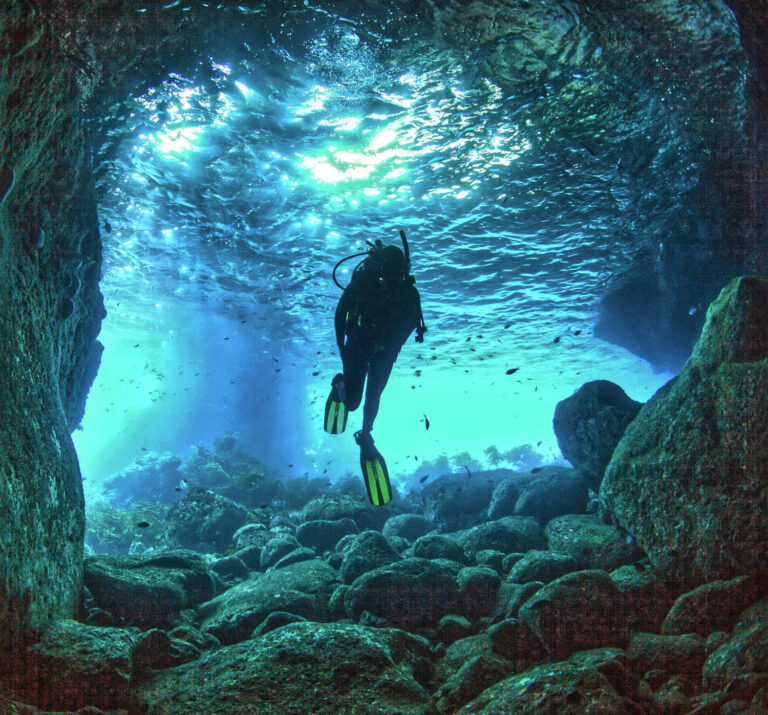Department of Conservation Marine Reserve
The Poor Knights Islands is usually in the top five places to dive in the world. This is due to the proximity of the continental shelf, warm ocean currents and the excellent visibility. And then there are choices about where to dive from artfully placed shipwrecks to naturally formed caves and coves.
Getting to the Poor Knights involves a boat. Tutukaka Marina is the hub for exploration of the marine world at their coastal doorstep. It is recommended forward bookings are made to avoid disappointment. Dive Tutukaka and Tutukaka Surf will support hiring of equipment, professional guides and arrange charters if required.

The Department of Conservation has created a list of twenty quirky facts about Poor Knights Island and the surrounding rocky outcrops.
- The Poor Knights are made up of two large islands and over 24 smaller inlets and rocky outcrops. Below the water, for 800 metres around the islands, is a marine reserve. Above, the islands are a nature reserve.
- Each year approx. 25,000 people visit the Poor Knights Marine Reserve.
- There are over 120 species with new species being discovered each year from nudibranchs to frogfish sightings.
- The origin of the island name is not clear, with some thinking it relates to the Poor Knights of Windsor, or, that the islands were named for their resemblance to Poor Knight’s Pudding (external site), a bread-based dish topped with egg and fried, popular at the time of discovery by Europeans.
- Jacques Cousteau ranked the Poor Knights as one of the top ten dive sites, anywhere in the world.
- Declared tapu by local Maori almost 140 years ago after a bloody massacre, the history is dramatic. Over 400 people once lived on the islands, with pa sites, marae, and terraced gardens.
- Locals call it the Cetacean Highway, as it’s directly on the migratory path of a number of species – Common and Bottlenose dolphins, several species of whales, including orca, humpback, blue, sperm whales, minke, Bryde’s and pilot whales


- A dead sperm whale washed up inside Rikoriko Cave, making it almost impossible to go inside due to the smell, and as the skeleton sunk, the massive jawbone remains at the bottom inside the cave.
- There are five known pa sites on the Island.
- The largest sea cave in the world by volume is Rikoriko Cave.
- In the Second World War a Japanese submarine tucked away inside the cave and stopped for two weeks whilst undergoing repairs.
- Rikoriko means waning light in Māori, twilight, or dancing light due to the patterns that the sunlight makes when reflected off the surface of the water upon the cave ceiling.
- Rikoriko cave is renown for its amazing acoustics – Herbs played their music in the cave, Wade Doak has submerged audio microphones in the water transmitting live sound and dolphins entered the cave and swam to the music. Neil Finn performed uncut in this natural auditorium. Gregorian Chants, Māori haka challenges, opera singers, Swiss yodellers, Irish folk singers, and didgeridoo players have made impromptu performances inside the cave.
- It is the only nesting place in the world for Buller’s shearwaters.
- There are over 1000 tuatara on the island, and they share the burrows with the shearwaters.
- There have never been any rats or mice or land-based mammals.
- The world’s largest insect, the giant weta is endemic to the Poor Knights.
- The Poor Knights Lily is endemic to the Poor Knights, they are flowering at the moment (spring)
- The plants here have gigantism – where they are larger than their mainland counterparts
- Every experience is different at the Poor Knights Marine Reserve and just when you think you’ve seen it all, you see something new and exciting
Poor Knights Marine Reserve turns 20: Media release 31 October 2018.


Our editors independently visit tour operators, purchase tickets, pay for accommodation, and rate products and places. We are not paid to go on a tour or visit a place. We only make money if you decide to purchase a product through our website links. You will not pay any extra, that is guaranteed.
We promise to never accept free products from manufacturers in return for boosting their products. Our independence and reviews is funded by your purchases and affiliate commissions, at no additional cost to yourself… read more about our affiliate programme in the terms and conditions HERE.
Travel pack information
BEST BITS TRAVEL GUIDE







